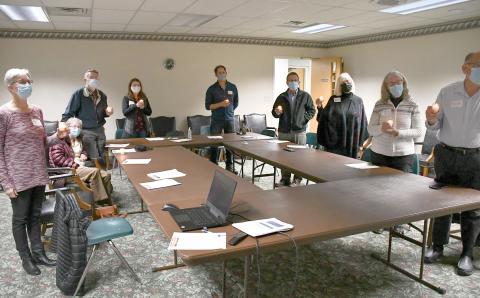Editor’s note: This article is the first in our newest series, “Seeking Shalom in the Midst of Polarization.” The series, in collaboration with The Colossian Forum, aims to examine the state of polarization in the U.S. and Canada and explore Christian strategies to overcome it. To read more articles in the series right now, visit TheBanner.org.
Human divisiveness began in the beginning. With the forbidden deed done, Adam blamed his wife and said to the Lord, “The woman you put here with me—she gave me some fruit from the tree, and I ate it” (Gen. 3:12). From Adam to Abel to Babel to Bethlehem, a biblical thread of social and relational discord entangles. Jesus arrived to a chorus of earthly peace (Luke 2:14), but soon acknowledged the enmity endemic to the human condition. He says, “Do you think that I have come to bring peace to the earth? No, I tell you, but division. From now on there will be five in one family divided against each other, three against two and two against three” (Luke 12:51-52), and “Do not suppose that I have come to bring peace to the earth. I did not come to bring peace to the earth, but a sword” (Matt. 10:34).
In Corinth, Paul appealed to the Holy Spirit to be power for the post-Pentecost church to cease its divisiveness and “be perfectly united in mind and thought” (1 Cor. 1:10). But church history records Christians in Corinth and elsewhere resisting unity and ferociously fighting over matters from the nature of God to the nature of nature itself. Churches split and denominations divide about the Trinity, Jesus’ identity, baptism and communion, human origins and gender, slavery and race, polity and politics, tongues and food, food and drink, drinking and dancing, and whether worship is better with an organ or a guitar.
In a church I led years ago, conflict over worship intensified just shy of fisticuffs as an organist shook an angry mitt in my face, declaring that “a damn band will never play in my sanctuary!” Nonplussed about the passion that music preferences incited, I inquired of a wise elder why he thought our congregation couldn’t forge some sort of compromise for unity’s sake. The elder explained that we don’t resolve our differences because of the sordid delight our anger ignites. “Part of the problem with being wrong is that it rarely feels like we’re wrong,” he said. “More often, being wrong feels like being right. And we love being right.”
Despite Jesus’ own prayers to the contrary (John 17:11) and the bonding power of the Spirit (Eph. 4:3), Christians descend into the same discordant morass witnessed in American culture at large. Many have sought to make sense of the extreme polarities that seem to dominate our cultural and political lives. In one such attempt, journalist George Packer delineates four narratives that currently compete for America’s moral identity in his article “How America Fractured Into Four Parts” (The Atlantic, July/August 2021). Drawing and adapting from Packer’s analysis of a “Free America,” a “Smart America,” a “Real America,” and a “Just America,” I similarly see four kinds of Christianities or churches in America (and to some degree in Canada too) that might shed some light on our own internal divisions.
“Free America” describes a libertarian impulse that places a high premium on personal freedom and small government. “Free Christianity” might best be seen in theologically conservative, independent churches devoid of denominational ties and led by celebrity-like pastors adept at quick theological adjustments depending on the needs of the moment. Free Christianity churches in growth mode tend to be consumer-oriented, focused on family and personal betterment, and advocating a spirituality of self-improvement more than sacrificial service. Metrics and methodology matter more than doctrinal precision.
I remember launching an alternative service at a traditional church I served in the 1990s. Using the best of current market research, we surveyed the neighborhood, studied demographics, determined our customer base, adjusted our liturgy, and massaged our theology to assure a certain attractiveness that succeeded in filling the sanctuary every Sunday night for years. That so many young people poured into our building to worship demonstrated our savviness and bore witness to our blessedness. Often large, production-heavy, program-driven, and results-oriented Free Christianity relies on what works numerically to determine what’s right.
“Smart America” represents people who are left-leaning, meritocratic, college-educated, technologically adept, health-conscious, privileged, posh, and particular. Cosmopolitan and multicultural, “Smart Christianity” likewise values education, merit, and technological swag and is evident mostly in upper-crust congregations and socially conscious urban churches striving for inclusive identities that downplay discomfiting biblical assertions such as judgment or hell or Christological exclusivity. Preachers go to great lengths to square a plain reading of Scripture with evolution and genetics as well as with postmodern thought and literary critique.
As a pastor in university-saturated Boston for many years, I served an extensively educated congregation loaded with doctorates sensitive to critiques of Christianity’s unreasonableness. Sermons flew over the heads of many, but it seemed better to obfuscate and come off as too academic than sound foolish. Equipped with my own doctorate, I likewise strove to cohere doctrinal truth with scientific discovery only to have the chair of Harvard’s physics department lambast an illustration I once deployed as “sermon science.” He told me to stick to Bible stories and leave research interpretations to the professionals. It took me days to craft the right words of response—I didn’t want him to think a theologian didn’t understand physics! (You can imagine how well this worked.)
“Real America” represents common folk left out by Free America’s trickle-down economics, which mostly favors wealthy corporations and individuals. Rural, nativist, populist, and local, “Real Christianity” is hostile to government intervention, modern ideas, and intellectual authority. Real Christianity churches are strong proponents of religious liberty and eager to help out a familiar friend but remain wary of outsiders. Susceptible to conspiracy theories, these folks trust their own research over experts and are averse to any outside opinions.
Working to earn money for seminary, I spent a summer pouring concrete with career laborers who spent their entire lives up to their knees in cement. One faithful man, listening to me go on about issues of biblical interpretation I looked forward to studying, dismissively shook his head over what he called “highfalutin’ mumbo-jumbo.” “All I need to know is Christ and him crucified,” he’d say. When I’d ask what that meant, he’d bark back that it meant what it said.
Lastly, “Just America” encompasses those promised a better life by having gone to (the right) school and working hard but who instead find themselves burdened with debt, underemployment, racial and economic disparity, and climate catastrophe. For these, white (male) supremacy is the greatest evil.
For years I served as pastor of Colonial Church near Minneapolis, named for its ties to New England congregationalism. After the murder of George Floyd in 2020, a movement arose to change Colonial’s name due to its implied racist and violent ties to European colonialism. Even years before, during a sabbatical in immensely multicultural Los Angeles, when I introduced myself as a minister at Colonial Church, internationals and racial or ethnic “others” would stare at me with wide-eyed puzzlement and sometimes disdain. I’d insist that we were surely postcolonial, and that our name derived from colonial New England congregationalists passionate for religious freedom and the gospel. One millennial replied, “Oh, you mean the congregational colonists who decimated the Wampanoag Indian tribe in Massachusetts and Rhode Island and sold their women and children into slavery?” “No, no, we’re in Minnesota,” I’d insist.
Just Christianity self-critiques through the historic grid of white, male dominance of theology and church structure, calling attention to all the ways Christianity has instigated injustice against women and people of color. But given the perceived perversity of the sin, any resulting repentance proves impermeable to grace. Outrage and intolerance are regarded as prophetic virtues. To have trespassed against the rights and identities of the historically oppressed cancels out any goodness or opportunity to attain forgiveness or make amends. As with Real America’s resentment, Just American judgment is an all-or-nothing, take-no-prisoners proposition.
Packer acknowledges that all four narrative slices respond to real problems, but the inability and unwillingness of each to engage with the other presents enormous challenges to ever resolving the problems. Ironically, Packer says, each narrative promotes important values that could contribute to a greater whole: “Free America celebrates the energy of the unencumbered individual. Smart America respects intelligence and welcomes change. Real America commits itself to a place and has a sense of limits. Just America demands a confrontation with what the others want to avoid.”
Inasmuch as these four narratives apply to the American church, similar positive contributions likewise emerge from each: Free Christianity stresses the importance of personal salvation and champions spiritual growth and depth. Smart Christianity embraces deep theology and the rich trove of thought that faith has inspired and applies it to real life for the sake of human and cultural transformation. Real Christianity embeds itself in local churches and communities and excels in building family and mutual care and concern. Just Christianity does deeds of social justice and critiques injustice prophetically to promote shalom for the world.
Rather than a Christianity divided, the four at their best could represent a diversity of gifts not unlike what Paul promotes in Corinth to counter the division there. Against the church split into factions based on their relative understandings of identity, loyalty, calling, and gifts, Paul appealed to anatomy as a cure. Paul writes,
There are many parts, but one body. The eye cannot say to the hand, “I don’t need you!” And the head cannot say to the feet, “I don’t need you!” On the contrary, those parts of the body that seem to be weaker are indispensable, and the parts that we think are less honorable we treat with special honor. And the parts that are unpresentable are treated with special modesty, while our presentable parts need no special treatment. But God has put the body together, giving greater honor to the parts that lacked it, so that there should be no division in the body, but that its parts should have equal concern for each other (1 Cor. 12:20-25).
Paul goes on to name the one body “the body of Christ,” establishing the heart and head around which each different set of gifts, passions, and perspectives unite. In Christ, the free needs the real needs the smart needs the just. All come together for good in the person of Christ.
Still, Christians diverge even over the person of Christ. Free Christianity paints him as a traditionalist, comfortable with authority and having a CEO leadership style. He’s pro-family even though he was never married or had children and seemed antagonistic even to his own blood relations at times (Matt. 12:47-48). Smart Christianity portrays Jesus as progressive, the ultimate intellectual, a clever teacher and storyteller for whom wit and intelligence always win the debate. Real Christianity stresses Jesus’ working-class roots and his love for children and homeland, while Just Christianity cites his minority status and brown skin and relishes his turning over the moneychangers’ tables and railing at the religious authorities. If you’re asked to describe Jesus in your own words, he’ll likely come off sounding a lot like yourself, with your same priorities and values.
This is why my concrete-shoveling companion insisted that any faith in Christ must be in Christ crucified. That Jesus was forced to carry his own cross and hang on it was public shame and condemnation of the worst kind. The cross denounces every attempt to remake Jesus into an idol of our self-interests. Churches affix big crosses to our walls primarily as symbols of victory and sacrifice, but the cross first indicts and destroys our old ways and sin.
Paul’s entire religious worldview and goodness as a Pharisee upended on that road to Damascus in Acts 9. In Acts 10, Peter’s whole understanding of righteousness came apart as unrighteous after a vision and a Gentile knock at his door. For both, preaching a crucified Christ proved invariably offensive. Jesus deliberately and willfully saves only through suffering and death, somehow turning a horrible thing into a holy thing—holy in that awful and terrifying way that God’s grace completely overwhelms and overrules. As the self-assured Saul-turned-Paul would finally and mercifully realize, “I have been crucified with Christ and I no longer live, but Christ lives in me” (Gal. 2:20). Extended to the church, “Christ living in us” is the essence of what Paul means by “the body of Christ.”
Christ crucified places Christians at constant odds with our culture. Crucifixion is what makes Christians opposed to violence and vengeance. Crucifixion defies aspirations of worldly wealth and power. Though the wisdom of God, it is considered foolish and weak (1 Cor. 1:23-24). Hardly provincial, Christ died to reconcile the whole world to himself (Col. 1:20). Undiscriminating, crucifixion makes way for the reconciliation of all things and the healing of division (2 Cor. 5:18).
The cross persists as the supreme emblem of God’s love for the world. Its insistence on suffering and sacrificial love for others remains the hallmark of Christian faithfulness. “If you love me, you will keep my commandments,” Jesus said (John 14:15, NRSV). And his chief commandment is to love one another as he has loved us (John 13:34). Paul famously asserts love as the only antidote to our factiousness (1 Cor. 13). Love bears and endures the worst while hoping and believing the best about everyone. Love never fails.
Discussion Questions
- Reading the author’s “four Christianities”—Free, Smart, Real and Just—which do you find describes you the most? Why?
- If the four Christianities each need the others, what do you think you need to learn more from the other Christianities that you don’t find yourself aligned with?
- What is your default favorite image of Jesus? Why is that so? What personal or cultural influences may have shaped your image of him?
- How does the priority of Christ crucified impact your default image of Jesus? How does the way of suffering and death—the way of the cross—affect your Free/Smart/Real/Just Christianity?
About the Author
Daniel Harrell is a hospice chaplain, author, teacher, longtime Congregational minister, and former editor-in-chief at Christianity Today. He holds a doctorate in psychology (Boston College) and lives in Minneapolis with his daughter.








